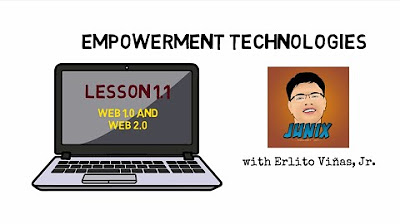There are TWO Versions of the Web
Summary
TLDRThe video discusses the evolution of the internet, from Web 1.0, where users were mainly passive content consumers, to Web 2.0, which introduced interactivity and dynamic web pages through technologies like JavaScript and Ajax. Web 2.0 also reshaped the internet as a platform for sharing, creating, and using software as a service. The video also touches on potential successors like Web 3.0, which could involve blockchain technology or an AI-dominated internet, though these concepts are still evolving and haven't fully replaced Web 2.0 yet.
Takeaways
- 🌐 The internet has evolved over time, leading some to suggest we're in the second or even third version of it.
- 📜 In the early 2000s, the web (Web 1.0) was mostly static with passive users, simple designs, and limited interactivity.
- 🖼️ Web 1.0 consisted of basic web pages like Geocities, with minimal user input and low interactivity.
- 🛠️ Web 2.0 introduced asynchronous changes in web pages through technologies like JavaScript and Ajax, enhancing interactivity.
- 💬 Web 2.0 also shifted the web's focus from consuming content to creating, sharing, and interacting with it.
- 🛒 Early adopters of Web 2.0, such as Amazon, emphasized user-generated content, followed by social media platforms like Myspace and Facebook.
- 💻 Web 2.0 popularized software as a service (SaaS), allowing companies to update software in the background.
- 🔗 Web 3.0, or Web 3, is still in flux, with competing ideas: one involving blockchain for decentralization and another focusing on the semantic web for machine-readable content.
- 🤖 Some see Web 3.0 as AI-dominated, with centralized control, countering the decentralized nature of blockchain.
- ❓ The future of the web remains uncertain, with no clear successor to Web 2.0 yet, but new technologies like AI and blockchain offer different potential directions.
Q & A
What is meant by the internet having a version history?
-The internet's version history refers to significant shifts in how the web is used and developed. These changes, although organic, have led to people labeling different eras as Web 1.0, Web 2.0, and potentially Web 3.0.
What characterizes Web 1.0?
-Web 1.0, which lasted until the early 2000s, was primarily a passive experience where users consumed content created by others. Pages were simple, often without dynamic elements, and user interaction was limited to features like guest books and message boards.
What was the role of early social media and online platforms in Web 2.0?
-Web 2.0 introduced the idea of users contributing content. Platforms like MySpace, Facebook, and Amazon encouraged interactivity, sharing, and creating content rather than just consuming it.
What technologies enabled the transition from Web 1.0 to Web 2.0?
-Technologies like JavaScript and Ajax allowed for asynchronous communication with servers, making web pages more interactive without requiring full page reloads. This shifted web design away from static content to dynamic, responsive pages.
How did Web 2.0 change the internet's fundamental use cases?
-Web 2.0 redefined the internet as a platform for interaction, where users could create and share content. It also introduced software as a service (SaaS), allowing companies to update services continuously, transforming how people engaged with online platforms.
What are the two competing ideas for what Web 3.0 might look like?
-One idea for Web 3.0 is the use of blockchain technology to decentralize control and enhance privacy. The other is the 'semantic web,' where web pages are machine-readable, allowing AI and other technologies to quickly understand and process content.
How does blockchain relate to the vision of Web 3.0?
-Blockchain's role in Web 3.0 is to decentralize the internet, reducing reliance on large corporations that control user data. This would promote more privacy and freedom online, but the widespread adoption of blockchain hasn't yet materialized.
What is the semantic web, and how does it differ from blockchain-based Web 3.0?
-The semantic web, another vision for Web 3.0, focuses on making web content more machine-readable through structured data and tagging. This contrasts with blockchain-based Web 3.0, which emphasizes decentralization and user privacy.
How does AI potentially factor into Web 3.0?
-AI could dominate a future version of the web by automating content processing and personalization. This contrasts with the decentralization goals of blockchain-based Web 3.0, which seeks to move away from centralized data control.
Why is it uncertain whether we have reached Web 3.0?
-There are multiple competing visions for Web 3.0, such as blockchain-based decentralization, the semantic web, and AI-driven systems. None have fully taken over yet, so it's unclear which, if any, will define the next major era of the internet.
Outlines

This section is available to paid users only. Please upgrade to access this part.
Upgrade NowMindmap

This section is available to paid users only. Please upgrade to access this part.
Upgrade NowKeywords

This section is available to paid users only. Please upgrade to access this part.
Upgrade NowHighlights

This section is available to paid users only. Please upgrade to access this part.
Upgrade NowTranscripts

This section is available to paid users only. Please upgrade to access this part.
Upgrade Now5.0 / 5 (0 votes)





